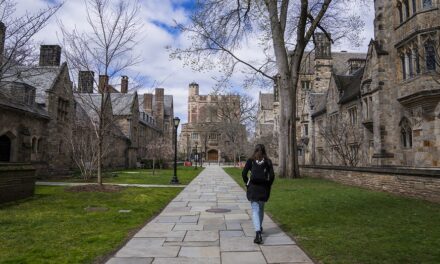In a move that has sparked significant controversy, a Virginia school has launched an educational display in honor of Women’s History Month that begins with the phrase “A is for Abortion.” This display, which covers the alphabet, aims to enlighten students on various topics associated with women’s history and health, but not without igniting heated debates among parents, educators, and community members.
The display was organized by a group of teachers at a local school, who intended to create a thought-provoking educational tool that also aligned with the values of inclusivity and awareness surrounding women’s rights and health issues. However, the opening letter of the alphabet has led to polarized opinions across the community, raising questions about the appropriateness of such a message in a school setting.
Those in favor of the display argue that it is crucial to educate young people about women’s rights and reproductive health options. Proponents believe that such transparency encourages informed discussions about crucial matters that affect women’s lives. Advocates maintain that knowledge about abortion is essential because it is a significant aspect of women’s rights, and discussing it helps students understand the broader context of women’s healthcare.
Supporters of the display have highlighted that Women’s History Month serves as an important platform to acknowledge women’s struggles and accomplishments throughout history, among which reproductive rights play a significant role. By teaching children about such an essential topic, they believe that future generations will grow up with a better understanding of the challenges that women continue to face today.
On the other hand, opponents of the display have taken a strong stance against the inclusion of abortion in an educational setting. Many parents and community members expressed their outrage and concern over what they see as the promotion of a controversial topic. Critics argue that introducing such subject matter in a school, especially to younger children, is inappropriate, and they assert that it transcends educational boundaries. Some view it as an agenda-driven initiative that seeks to impose particular beliefs on impressionable minds.
The backlash has led to heated discussions within school board meetings and community forums. Parents have rallied to express their opposition, claiming that the display does not reflect their values or the sentiment of the broader community. They argue that discussions about abortion are complex and should involve families, not be foregone conclusions within an educational curriculum.
Several school board members have also voiced their concerns about the display’s implications, saying that while the intention behind it may have been educational, the execution was fundamentally flawed. They argue that controversial subjects should be approached with more sensitivity and community involvement to garner diverse perspectives and opinions.
As part of the campaign, some concerned citizens have called for a re-evaluation of the school’s approach to teaching reproductive rights. They suggest integrating a more balanced discussion on various viewpoints surrounding the topic, ensuring that students are exposed to a variety of perspectives, rather than framing a single narrative as the only truth. Proponents of this approach believe that it could foster critical thinking and encourage respectful discourse among students.
In response to the outcry, school administrators have stated that the display was not meant to endorse any particular viewpoint. Instead, they emphasized their commitment to presenting educational materials that cover the complexities of women’s health and history in a way that complies with the curriculum standards. They have reiterated the importance of teaching about women’s rights, stating that understanding the past allows students to engage thoughtfully with present-day issues.
The display is part of a broader movement within some educational institutions aiming to integrate discussions about social justice, equity, and individual rights into school curriculums. As schools increasingly recognize the importance of fostering informed and engaged citizens, discussions surrounding topics like women’s rights have gained traction. However, the balance between education and parental values remains a contentious issue.
In light of the controversy, it is essential to consider how educational institutions address sensitive subjects. Many educators are trained to handle complex discussions in ways that respect both viewpoints and promote open dialogue among students. Engaging students in respectful debates and encouraging them to critically analyze varying perspectives can empower them to become informed individuals capable of navigating challenging social issues.
As the debate continues, the community appears to be divided. Some members assert that it is crucial for schools to reflect modern values and foster discussions about real-world issues that affect young people today. Meanwhile, others adamantly believe that schools should prioritize a more traditional educational focus, steering clear of controversial subject matters that could polarize families.
The situation has brought to the forefront the ongoing national conversation about education, parental rights, and the role of schools in addressing sensitive issues. As the academic year progresses, this incident may serve as a catalyst for discussions around curriculum content and the need for clearer communication between schools and families about what is being taught in the classroom.
Amidst the uproar, state representatives and political figures have begun weighing in on the debate, with some issuing statements of support for the display while others have condemned it. This involvement highlights how educational matters have significant political implications and can often become intertwined with broader societal debates regarding rights and freedoms.
The controversy at the Virginia school exemplifies a growing trend in American education where discussions about sensitive topics have become increasingly fraught with tension. As schools attempt to tackle real issues facing society, they are met with both support and opposition—demonstrating the complexity of navigating modern educational landscapes.
Ultimately, the school aims to remain committed to fostering a safe and respectful environment for all students, educators, and families while ensuring educational integrity. The incident underscores the importance of inclusive dialogue, cooperative learning experiences, and the necessity for empathy among differing viewpoints within educational settings.
As various stakeholders continue to engage with the topic, it is vital for educational institutions to find a balance between teaching essential topics, respecting family beliefs, and creating an inclusive atmosphere for all students. The resolutions and outcomes from this debate could have far-reaching implications not only for the school in question but also for other educational institutions navigating similar challenges across the nation.
In conclusion, the display’s inception has raised critical questions about the role of education in societal discourse, the intersection of rights and responsibilities, and how best to engage young minds with the complexities of history and current events. As the discourse unfolds, it remains to be seen how the educational landscape will evolve to address the varying perspectives and needs of students and their families in a rapidly changing world.
































